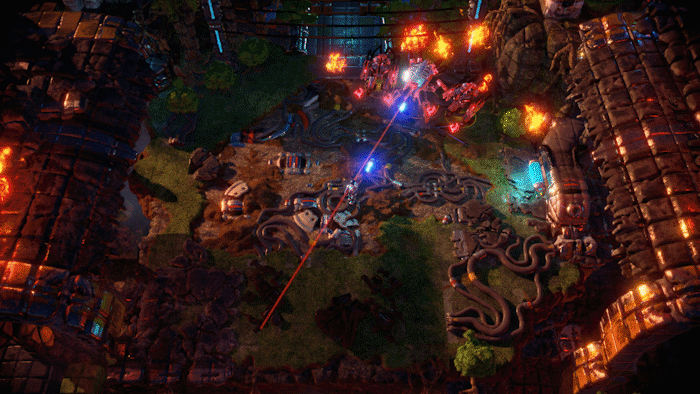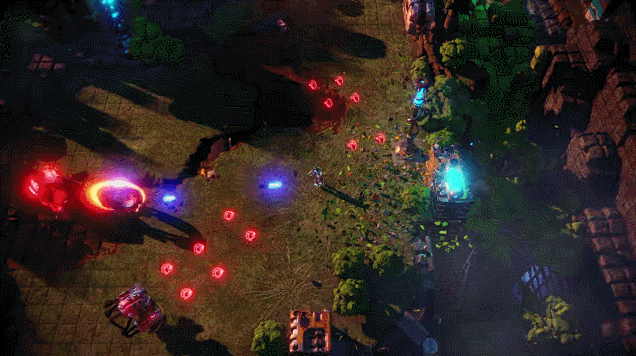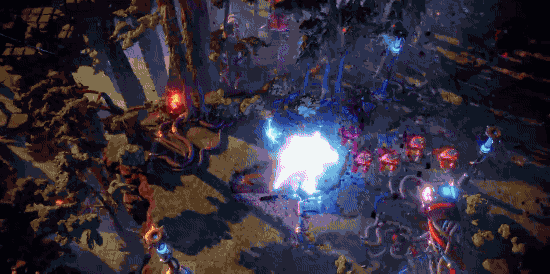Starward Rogue [Review]
Starward Rogue is a game with an interesting mix of genres that ultimately doesn’t have enough weight.
Image credit: Arcen Games / Klabater
In Starward Rogue from Arcen Games and Klabater, you’re a head in a mech, tasked with delving deep into the Megalith, a space prison. I played the game’s just released console version on the PS5.
This Megalith starts off with five levels, each with randomized rooms and random bosses. As you complete successful runs, the dungeon expands—it gets deeper and deeper. There are over 500 room types the game uses to build each floor, and in my experience they were quite varied.
As you'd expect from a good roguelite, more weapons, upgrades, and consumables are unlocked over time to appear during your runs. Starward Rogue has a great variety of them, over 350. The player can have one weapon, one energy-consuming subweapon, one mod, and one consumable equipped at any given time. Some items become passively equipped, such as helper drones. The drones were one of my favorite parts of the game; there's a plethora of them with different qualities, and things get crazy when you manage to get a bunch of them equipped.
Image credit: Arcen Games / Klabater
The drones remind me of Options in Gradius, with good reason. Starward Rogue isn't just a roguelite top-down arena shooter, it's also a SHMUP. The game has over 150 enemies and a wide array of minibosses and bosses that it'll throw at you as it ramps up its bullet hell. Like in any top-down shooter, the player can move and shoot in 360° using the controller thumbsticks, so it creates a different dynamic than the average single-direction autoscrolling bullet hells.
I couldn't really get into the game the first time I played. Some issues bothered me and turned me off. I still consider those issues as negatives for the game, but when I played it again and spent more time with it, I enjoyed my time. The gameplay loop is addictive and executed better than a lot of other roguelites, and I liked the pace at which new items are added to the mix. I also really like the idea of gradually increasing the depth of the dungeon. It makes completing a run feel much more attainable by giving you smaller goals, rather than simply telling the player there's a huge number of levels ahead of them immediately. But when I consider the issues I had with the game, I don't see myself coming back to it for long.
Image credit: Arcen Games / Klabater
Let's delve into these issues. When comparing Starward Rogue to some of my favorite top-down shooters, the game falls short. The graphics are too flat, in that the art doesn't do enough to distinguish enemies, hazards, or block types from the background. Normal enemies don't look different enough from each other—their silhouettes are too similar. Likewise, different block types look too similar to each other, and dangerous hazards like spiky floor tiles aren't distinct enough. I'd find myself walking over the spikes all the time without noticing.
My biggest gripe that I just can’t overlook is that the game lacks a satisfying game feel and doesn’t have enough juice. Everything feels weightless, and there isn’t enough tactile feedback for the player, making playing the game feel unsatisfying. For an example of how to succeed with juice, we can look at Housemarque’s Nex Machina, a masterclass in top-down shooters that’s extremely juicy.
Yes, the game has 3D art, but the same principles apply. If you look at some of the gifs I’m including here for reference, you can see that all player actions and events in the world result in feedback. Bullets hitting walls explode in sparks. Enemies brightly flash when hit and explode in a satisfying particle-filled pop that sprays in the direction of your shots when killed. Of course, all of this is accompanied by highly satisfying sound effects that scratch that arcade itch just right. This can also all be accompanied by other sensory feedback like controller vibrations. This is catnip. This kind of polish is what keeps someone coming back to a game for years.
Starward Rogue does some of this, but not nearly enough. Enemies all feel like bullet sponges, and aside from seeing an HP bar drop and weak glows, I don’t get a sense I’m doing real damage. The tiny sprite explosions from bullet hits don’t feel like a real impact; most bullets simply disappear when hitting a wall. Adding something like having normal enemies be pushed back by the power of your attacks would have gone a long way. It would have added that weight the game is missing.
If the game had been satisfying in this tactile way, I would have held it in much higher regard. Because the core differentiator of this game from other roguelites is that it’s a shooter, I just can’t forgive these faults.
Starward Rogue is available on Steam for PC, Playstation 4 / 5, Nintendo Switch, and Xbox One / Series X|S.
Overall Score: 4/10
Played on: PS5




